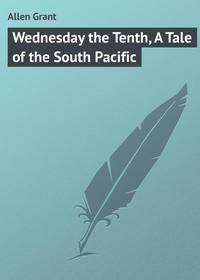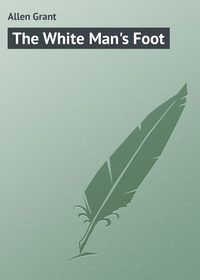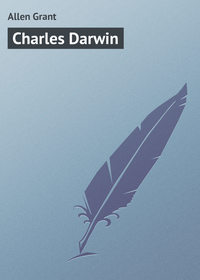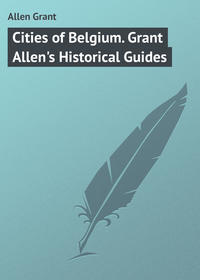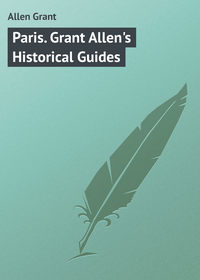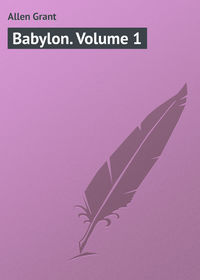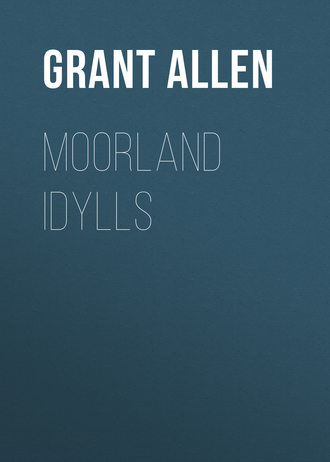 полная версия
полная версияMoorland Idylls

Grant Allen
Moorland Idylls
I.
THE NIGHT-JAR
We sat late on the verandah last night, listening to the low trilling croon of the night-jar. It was a balmy evening, one of the few this summer; the sunset was lingering over the heather-clad moors, and the lonely bird sat perched on one bough of the wind-swept pine-tree by Martin’s Corner, calling pathetically to his mate with that deep passionate cry of his. I know not why, but the voice of the night-jar seems to me fuller of unspoken poetry than that of any more musical and articulate songster. Away down in the valley a nightingale was pouring his full throat among the oak-brush; but we hardly heeded him. Up on the open moorland, in the twilight solitude, that grey bird of dusk sat keening and sobbing his monotonous love-plaint; and it moved us more than all the nightingale’s gamut. I think it must be because we feel instinctively he is in terrible earnest. Those profound catches in the throat are the very note of true love; they have in them something of high human passion. And we could see the bird himself, too, on his half-leafless perch, craning his neck as he crooned, and looking eagerly for his lady-love. It was a delicious moment. We murmured as we sat George Meredith’s lines —
“Lovely are the curves of the white owl sweeping Wavy in the dusk lit by one large star.Lone on the fir-branch, his rattle-note unvaried, Brooding o’er the gloom, spins the brown eve-jar.”We were fortunate indeed in our mise-en-scène; for the poet’s picture had realized itself before us. And, as usual, art had reacted upon nature. The cry, that was so beautiful and romantic in itself, gained an added touch of beauty and romance from the great word-painter’s exquisite images.
Perhaps, too, some part of the charm in the night-jar and his kind may be due to the sense that here at least we stand face to face with a genuine relic of the older, the wilder, and the freer England. He is a bird of the night, of the heather and the bracken, of the unbroken waste, of the unpeopled solitude. When man invades his high home, he moves afield before the intruder. Here on the great moors we hear him nightly in summer; but only when no other sound assails the ear, save the boom of the cockchafer, and the myriad hum of the flies and moths of dusk among the heather. He belongs, in fact, to that elder fauna which inhabited England before the whirr of wheels and the snort of steam drove the wild things far from us. The perky sparrow can accommodate himself without an effort to the bustle of towns, and can dispute for grains of corn under the horses’ hoofs in Cheapside; the rook can follow close the ploughman’s heels, in search of worms turned up by the share in the furrows; but the night-jar lives aloof among the solitary fern-wastes, and flies amain before the intrusion of our boisterous humanity.
“Fern-owls” the country people hereabouts call them; and very owl-like indeed they are in outer appearance, with their soft mottled plumage, all brown and grey and melting white, as is the wont of nocturnal or crepuscular creatures. But they are not owls at all by descent, for all that, being in reality big fly-hunting cousins of the swifts and the humming-birds. All birds that hawk after insects on the wing have a wide gaping mouth; the house martins have it, and the swallows, and the swifts; but in the night-jar this width of gape is pushed to a singular and almost grotesque extreme, though not of course beyond the limit laid by the needs and habits of the animal. It is the enormous mouth, fringed with its strange line of coarse bristles along the beak, that has gained for our night-jar its common European name of goatsucker. And indeed, if you watch close on southern upland farms, among the Apennines or the Atlas, you will see the night-jars at twilight hovering close by the udders of the goats and cattle as they lie stretched in the meadows. But they are not milking them, as the Italian peasant firmly believes; it is as friends and allies that they come, not as enemies. Peer hard through the gloom, on a moonlit evening, and you can make out at last that nocturnal flies are annoying the beasts, and that as fast as they gather the night-jar snaps them up, while the cattle seem to recognize this friendly office by never whisking their tails so long as the bird attends to them. It is a mutual convenience, an early form of that consorting for purposes of common advantage which reaches at last its highest development in the nest of ants, with their associated beetles and their cow-like aphides.
Here in England, our night-jar is but a summer migrant, a visitor to the moors while insects abound; and we listen for him eagerly in warm May weather. He comes to us from South Africa, where he winters among the Zulus, or, rather, escapes the chill of winter altogether in the opposite hemisphere. For he must have insects, flying insects on the wing, and plenty of them. We welcome his first churring among the pines and bracken as a sign of summer; for he is a prudent bird, and seldom makes a mistake, knowing the marks of the weather well, like Mr. Robert Scott, and delaying his arrival till insects have hatched out in sufficient numbers from the cocoons over the heather-clad uplands. You see him but rarely, for he loves the dusk, and, though far from a timid bird, he usually alights on the ground, hardly perching on a tree, I think, except to utter his love-call. When he does perch, it is always lengthwise to the bough, not crosswise, as is the fashion with most other birds; he seems afraid of falling; and then, this position also assorts better with his passionate attitude of craning expectancy as he leans forward on the branch to summon his helpmate. If you disturb him from the ground, he rises with flapping wings in an awkward and noisy way, bringing his pinions together above his body, somewhat after the lapwing’s fashion; but when he hawks on the open after flies, with his big mouth agape, his long arcs of flight are equable, swift, and graceful. Night-jars are fearless beasts; they rear their young in the open, without pretence or concealment. The two veined and marbled eggs are laid boldly in some hard patch among the brake and gorse, on the bare ground, without a nest of any sort; and though they are beautifully coloured when you come to examine them in detail, they so closely imitate the soil and the dry heath around in general effect, that you may easily pass them by, even when you have marked their approximate place by disturbing the sitting mother. Few British birds, indeed, show higher and closer adaptation to special conditions than our dreamy night-jars, essential insect-hawkers of the dusk on open and treeless uplands. Their large and mysterious eyes, their gaping mouths, their straining fringe of bristles, their delicate owl-like plumage, their swift and silent flight, their agile movements, their eerie cry, their curious love-sick nature – all mark them out as marvellously modified nocturnal variants on the general type of the swifts and trogons. They are, in fact, specialized descendants of the same primitive ancestral form, whose bodies and souls have undergone weird and beautiful changes in adaptation to a wild and poetical life in the shades of dusk on the unpeopled moorlands. For birds of twilight have always passionate cries and passionate natures; not accident alone has given us the whip-poor-will and the nightingale.
II.
PROPHETIC AUTUMN
The year used once to begin in March. That was simple and natural – to let it start on its course with the first warmer breath of returning spring. It begins now in January – which has nothing to recommend it. I am not sure that Nature does not show us it really begins on the first of October.
“October!” you cry, “when all is changing and dying! when trees shed their leaves, when creepers crimson, when summer singers desert our woods, when flowers grow scanty in field or hedgerow! What promise then of spring? What glad signs of a beginning?”
Even so things look at a superficial glance. Autumn, you would think, is the season of decay, of death, of dissolution, the end of all things, without hope or symbol of rejuvenescence. Yet look a little closer as you walk along the lanes, between the golden bracken, more glorious as it fades, and you will soon see that the cycle of the year’s life begins much more truly in October than at any other date in the shifting twelvemonth you can easily fix for it. Then the round of one year’s history draws to a beautiful close, while the round of another’s is well on the way to its newest avatar.
Gaze hard at the alders by the side of this little brook in the valley, for example, or at the silvery-barked birches here on the wind-swept moorland. They have dropped their shivering leaves, all wan yellow on the ground, and the naked twigs now stand silhouetted delicately in Nature’s etching against the pale grey-blue background. But what are those dainty little pendulous cylinders, brown and beaded with the mist, that hang in tiny clusters half-unnoticed on the branches? Those? Why, can’t you guess? They are next April’s catkins. Pick them off, and open one, and you will find inside it the wee yellowish-green stamens, already distinctly formed, and rich with the raw material of future golden pollen. The birch and the alder toiled, like La Fontaine’s ant, through all the sunny summer, and laid by in their tissues the living stuff from which to produce next spring’s fluffy catkins. But that they may lose no time when April comes round again, and may take advantage of the first sunshiny day with a fine breeze blowing for the dispersal of their pollen, they just form the hanging masses of tiny flowers beforehand, in the previous autumn, keep them waiting in stock, so to speak, through the depth of winter, and unfold them at once with the earliest hint of genial April weather. Observe, though, how tightly the flowerets are wrapped in the close-fitting scales, overlapping like Italian tiles, to protect their tender tissues from the frost and snow; and how cleverly they are rolled up in their snug small cradles. As soon as spring breathes warm on them, however, the close valves will unfold, the short stamens will lengthen into hanging tassels, and the pollen will shake itself free on the friendly breezes, to be wafted on their wings to the sensitive surface of the female flowers.
Look, again, at the knobs which line the wand-like stems and boughs of the willows. Do you know what they are? Buds, you say. Yes, leaves for next spring, ready-made in advance, and curled up in embryo, awaiting the summer. If you unfold them carefully with a needle and pocket-lens, you will find each miniature leaf is fully formed beforehand: the spring has even now begun by anticipation; it only waits for the sun to unfold and realize itself. Or see, once more, the big sticky buds on the twigs of the horse-chestnut, how tightly and well they protect the new leaves; and notice at the same time the quaint horseshoe scar, with marks as of nails, left where the old leaves have just now fallen off, the nails being, in point of fact, the relics of the vascular bundles. Death, says the old proverb, is the gate of life. “Le roi est mort; vive le roi!” No sooner is one summer fairly over than another summer begins to be, under the eyes of the observer.
To those among us who shrink with dread from the Stygian gloom of English winter, there is something most consoling in this cheerful idea of Prophetic Autumn – this sense that winter is but a temporary sleep, during which the life already formed and well on its way to flower and foliage just holds its breath awhile in expectation of warmer weather. Nay, more, the fresh young life of the new year has even begun in part to show itself already. Autumn, not spring, is the real season of seedlings. Cast your eyes on the bank by the roadside yonder, and what do you see? The ground is green with tiny baby plants of prickly cleavers and ivy-leaved veronica. The seeds fall from the mother-plant on the soil in August, sprout and germinate with the September rains, and have formed a thick carpet of spring-like verdure by the middle of October. That is the common way with most of our wild annuals. Unlike so many pampered garden flowers, but like “fall” wheat in cold climates, they sow themselves in autumn, come up boldly at once, straggle somehow through the winter, of course with enormous losses, and are ready by spring to welcome the first rays of returning sunshine.
Even the animals in like manner are busy with their domestic preparations for next summer. The foundress wasps, already fertilized by the autumn brood of drones, are retiring with their internal store of eggs to warm winter quarters, ready to lay and rear them in the earliest May weather. The dormouse is on the look-out for a snug hiding-place in the hazels. The caterpillars are spinning cocoons or encasing themselves in iridescent chrysalis shells, from which to emerge in April as full-fledged moths or gay cabbage butterflies. Everything is preparing for next summer’s idyll. Winter is but a sleep, if even that; thank Heaven, I see in autumn the “promise and potency” of all that makes June sweet or April vocal.
III.
OUR WINGED HOUSE-FELLOWS
We have been sitting this afternoon in the Big Drawing-room, enjoying the view from its extensive windows. It is a spacious apartment for so small a house – about three acres large, with windows that open all round over miles of moorland. The carpet has a groundwork of fallen pine-needles and green grass and bracken, irregularly threaded with a tiny pattern of brocaded flowers – yellow tormentil, white bedstraw, golden stonecrop, red sheep-sorrel; while by way of roof the room is covered by a fretted ceiling of interlacing fir-branches, through which one can catch at frequent intervals deep glimpses of a high and bright blue dome that overarches with its vast curve the entire Big Drawing-room. No finer throne-hall has any earthly king; it is quite good enough for ourselves and our visitors.
But as we leaned back in our easy-chairs – spring seats of brake, backed with a bole of red pine-bark – we gazed upward overhead through the gaps in the boughs, and saw our winged house-fellows, the black-and-white martins, sweeping round in long curves after flies in the sunshine. It was immensely picturesque for the martins and ourselves; how the flies regard the question I forbear to inquire at the present juncture. We had lamb chops for lunch; let him that is without sin amongst us – for example, the editor of the Vegetarian Times – cast the first stone at the house-martins. For myself, I am too conscious of carnivorous and other sinful tastes to cast stones at anybody. We are all human, say I, or at any rate vertebrate; let us agree to take things with vertebrate toleration.
The house-martins abide under the same roof with ourselves; literally under the same roof, for their tiny mud nests cling close beneath the eaves of our two spare bedrooms, familiarly known as the Maiden’s Bower and the Prophet’s Chamber – the last because it is most often inhabited by our friend the curate, and furnished, after the scriptural precedent, with “a bed, and a table, and a stool, and a candlestick” – “Every luxury that wealth can afford,” said the Shunammite lady. “Under our roof,” we say, when we speak of it; but the house-martins think otherwise. “Goodness gracious,” I heard one of them twitter amazed to his wife the day we moved in for the first time to our newly-built cottage, “how terribly inconvenient! Here are some of those great nasty creatures, that walk so awkwardly erect, come to live in our house without so much as asking us. How they’ll frighten the children!” For to tell you the truth, they were here before us. They came while the builders were still occupied in giving those “finishing touches” which are never finished; and they regarded our arrival as an unwarrantable intrusion. I could tell it from the aggrieved tone in which they chirped and chattered: “Gross infringement of the liberty of the subject;” “In England, every martin’s nest is called his castle;” “Was it for this our fathers fought and bled at Agincourt against the intrusive sparrows?” – and so forth ad infinitum. But after a day or two, they cooled down and established a modus vivendi, the terms of the concordat being that we mutually agreed to live and let live, they under the eaves, and we in the interior. Since then, this arrangement has been so honourably carried out on both sides by the high contracting parties, that the martins allow us to stand close under them on the garden terrace, and watch while they bring flies in their mouths to their callow young, which poke out their gaping mouths at the nest door to receive them. They know us individually, and return with punctuality and despatch to their accustomed home each summer. But when strangers stand by, I notice that, though the parent birds dart back to the nest with a mouthful of flies, they do not dare to enter it or to feed their young; they turn hurriedly on the wing, three inches from the door, with a disappointed twitter, a sharp cheep of disgust, and won’t return to their crying chicks, which strain their wide mouths and crane their necks to be fed, till the foreign element has been eliminated from the party.
For myself, I will admit, I just love the house-martins. They may be given to eating flies; but what of that? The skylark himself – Shelley’s skylark, Meredith’s skylark – affects a diet of worms, and nobody thinks one penny the worse of him. Even Juliet, I don’t doubt, ate lamb chops like the rest of us. Indeed, it happened to me a few mornings since, during some very hot weather, to be positively grateful for these insectivorous tastes on the part of our feathered fellow-citizens. We were sitting on the verandah, much tried by a plague of flies; it was clear that “the blood of an Englishman” attracted whole swarms of midges and other unwelcome visitors. As soon as the house-martins became aware of this fact, they drew nearer and nearer to us in their long curves of flight, swooping down upon the insects attracted by our presence before they had time to arrive at the verandah. We sat quite still, taking no notice of the friendly birds’ manœuvres; till after a while they mustered up courage to come close to our faces, flying so low and approaching us so boldly, that we might almost have put out our hands and caught them. I am aware, of course, that the martins merely regarded us from the selfish point of view, as fine bait for midges; while we in return were glad to accept their services as vicarious flycatchers. But on what else are most human societies founded save such mutual advantage? And do we not often feel real friendship for those who serve us for hire well and faithfully? In the midst of so much general distrust of man, I accept with gratitude the confidence of the house-martins.
All members of the British swallow-kind are amply represented in and about our three acres. The common swallows breed under the thatched eaves of the ruined shed in the Frying Pan, and hawk all day over the shallow trout-stream that bickers down its middle. You can tell them on the wing by their very forked tail. It is, I think, in part a distinguishing mark by which they recognize their own kind, and discriminate it from the martins; for the outer-tail feathers are particularly long and noticeable in the male birds, whence I take them to be of the nature of attractive ornaments. At the beginning of the breeding season, too, the males assume a beautiful pinky blush on the lighter parts of the plumage, which may specially be observed as they turn flashing for a moment in bright April sunshine. The sand-martins, again, the engineers of their race, have excavated their long tunnelled nests in the crumbling yellow cliff that flanks the cutting on the high road opposite; I love to see them fly in with unerring aim at the narrow mouth as they return all agog from their aërial hunting expeditions on cool summer evenings. They are the smallest and dingiest of our swallows; they have no sheeny blue-black plumage like their handsome cousins, but are pale brown above, and dirty white below. The house-martin, last of all, can be recognized at once upon the wing by his conspicuous belt of pure white plumage, almost dazzling in its brilliancy, which stretches in a band across the lower half of his back; as he pirouettes on the wing, this badge of his kind gleams for a moment against the sky, and then fades as if by magic. His shorter tail scarcely shows forked at a distance, but when you watch him at close quarters, it is delightful to observe how he broadens or narrows it as he flies, to steady and steer himself. In order fully to appreciate this point, however, you must have the quick keen eye of the born observer. As for the pure black swifts – those canonical birds that haunt the village steeple – they are not swallows at all, but dark and long-winged northern representatives of the humming-birds and trogons. All these alike are summer migrants in England, for they can but come to us when insects on the wing are cheap and plentiful.
IV.
A NEIGHBOURLY GOSSIP
I love gossip. For my own part, I can never see the point of the objections which some people raise against talking over the concerns of your neighbours’ families. They are always so interesting. I like to know all about them. I like to pry into their most intimate secrets. I like to find out what they do with themselves all day long; and what they have to eat for dinner; and how they make their living; and where or in whose company they spend their evenings. I like to watch where they build their homes, and how many eggs they lay, and how they hatch them out, and what becomes of the fledgelings. I like to spy out where others hibernate in the woods, and what store of nuts and fruits they have laid by to provide against the Christmas scarcity. You may think this sort of Paul Pry interest in the affairs of your fellow-creatures is undignified and unphilosophic; but I confess, to me it appears only neighbourly.
For example, there are my friends the missel-thrushes, who have just lately returned for the winter months to their commodious quarters in the hanger below me. A week or two since I noticed them flying home to the woods and parks in their thousands. They have been spending the summer months as usual on their moors in Norway; but food having lately begun to fail them on the fjelds, they are coming back now in great straggling flocks to their English residences. For, unlike the song-thrush, who is one of their closest and most distinguished relations, they stay with us in the winter only, and move north again betimes in late spring, as soon as their broods are reared and whortleberries are getting plentiful in the northern moorlands.
Questions of commissariat, indeed, have most to do with the migrations of birds; it is not weather, as weather, but the condition of the food-supply that mainly regulates their periodical movements. Now, the missel-thrush is almost entirely vegetarian in his habits; whereas his cousin, the song-thrush, subsists for the most part on a regimen of worms and other miscellaneous unsavoury animals. Hence it follows, of course, that the missel-thrush must needs go where berries are in season; he follows them closely across the face of Europe, from province to province. He cannot stand great cold, however, and often freezes to death in severe winters; which is another reason why he comes south for warmth when Norwegian hills rise white with snow, and fjords are blocked with ice, and crystal-frosted pine-trees glisten in the sun with innumerable diamonds. Family parties of missel-thrushes may be seen in our fields the whole winter through; but they are timid and wary, and fly off in a body at the faintest suspicion of coming danger. You can tell them as they rise on the wing by the conspicuous white patch under the pinions, which seems, like the rabbit’s tail, to act as a danger-signal to the rest of the household. No sooner does one of them scent a stranger afar off than he rises silently, and the others, alarmed by his contagious fear, rise after him one by one in a picturesque line, somewhat as one often sees in the case of wild-fowl. In February and March your missel-thrush begins to build in the hawthorns and apple-trees; and the moment his nestlings are strong enough of wing to buffet the strong winds of the German Ocean, the whole family flits north again to its Norwegian estate for the cloudberry season. The nests, however, though built somewhat overtly on bare and leafless boughs, are most difficult to find; for the cunning little architects, knowing well they will get no protection from a canopy of foliage, conceal their homes adroitly with an outer coat of woven moss and lichen, which so harmonizes with the grey and lichen-covered branches around them as to make them almost indistinguishable. The eggs are stone-grey, daintily spotted and blotched with round blobs of brown ochre.




